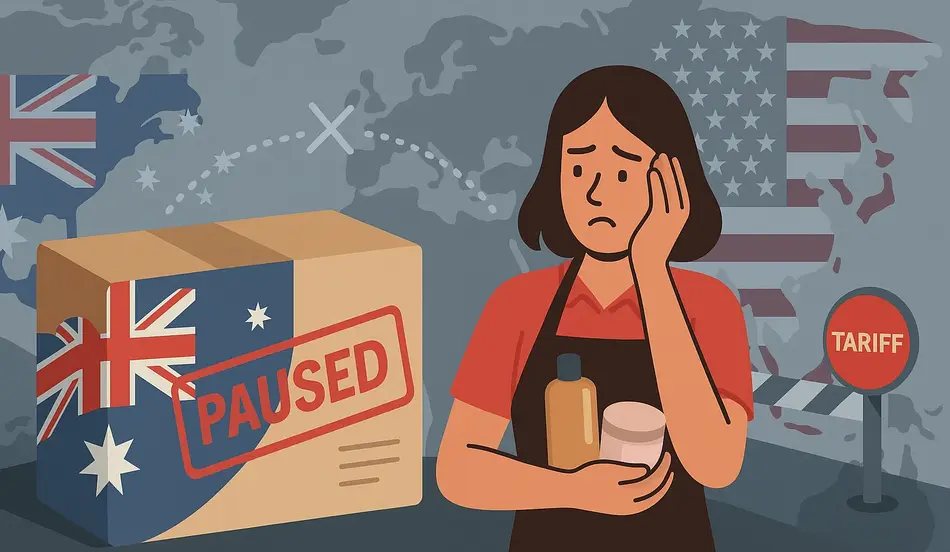Small and medium-sized exporters across Australia have been thrown into disarray after Australia Post announced a temporary suspension of small parcel shipments to the United States. The move comes just days before the U.S. government eliminates its de minimis tariff threshold, meaning all goods, regardless of value, will now attract duties and taxes when entering the country.
The decision highlights the ripple effects of shifting U.S. trade policy under the Trump administration, and the challenges small businesses face in navigating a more complex global trading environment.
The End of the De Minimis Exemption
For decades, American consumers and foreign exporters benefited from the de minimis threshold — a rule exempting imported goods valued under US$800 from duties. The arrangement allowed cross-border e-commerce to thrive, with small parcels flowing easily across the Pacific.
But starting this Friday, the threshold will shrink from US$800 to zero, meaning even a US$20 T-shirt will attract a tariff.
Supporters of the policy shift, including U.S. labor groups, argue that the previous exemption unfairly advantaged foreign exporters and undermined domestic manufacturers. Critics say it will add costs, delays, and red tape to businesses worldwide that rely on the American market.
Australia Post Pauses, FedEx Pushes On
Caught in the middle, Australia Post announced it had no choice but to suspend certain shipments while it works out how to comply.
“We’re disappointed we have had to take this action,” said Gary Starr, general manager at Australia Post. “However, due to the complex and rapidly evolving situation, a temporary partial suspension has been necessary to allow us to develop and implement a workable solution for our customers.”
In contrast, global shipping giants such as FedEx are continuing deliveries. The company has already adjusted to similar tariff regimes introduced for Chinese and Hong Kong exports earlier this year.
“We will continue to ship to the U.S., albeit that small businesses in Australia just need to navigate what changes that means for their business,” said Peter Langley, regional vice president of FedEx in Australia.
How the New Rules Work
To understand the change, consider the example of shipping a men’s jacket worth AU$450 (about US$300) to the United States.
- Before August 29: Exempt under the de minimis rule. No duties payable.
- After August 29: Importer or shipper must provide a highly detailed classification using the Harmonized System (HS) code. Instead of simply declaring it a “jacket,” the description must read something like: Men’s jacket, 80% wool, 20% linen.
- Based on that code, the tariff is applied — in this case, roughly 18%, or US$54.
That fee can either be collected upfront in Australia by the courier (such as FedEx, which then transfers the payment to U.S. customs) or at the border by the U.S. importer.
For small businesses accustomed to frictionless trade, the adjustment will require new systems, new paperwork, and additional costs.
Costs Beyond Freight
Adding to the complexity, tariffs are separate from freight charges.
A quick calculation on FedEx’s online tool shows that a 10-kilogram parcel shipped from Australia to the U.S. could cost between AU$470 and AU$510 in freight, depending on speed. Tariffs would be calculated on top of that, based on the exact product classification.
This means Australian businesses will have to make tough choices:
- Absorb the new costs, which will eat into margins.
- Pass them on to U.S. consumers, potentially making products less competitive.
- Seek alternative markets, diversifying away from the U.S.
Small Businesses Hit Hardest
While multinational companies can deploy compliance teams and customs brokers, small firms face a steeper challenge.
“U.S. buyers are a huge market for Aussie small businesses,” said one Sydney-based e-commerce consultant. “But the sudden removal of the de minimis threshold is like pulling the rug out. A lot of sellers won’t have the resources to manage the new red tape.”
The low Australian dollar, hovering around 65 U.S. cents, had given exporters a competitive edge in pricing. Now, tariffs may offset much of that advantage.
Why the U.S. Changed the Rules
The Trump administration has framed the move as part of a broader effort to protect American jobs and manufacturing. By closing what it called a “loophole” in online retail imports, Washington hopes to tilt the playing field back toward domestic producers.
But trade economists warn of unintended consequences. Tariffs often raise prices for U.S. consumers and complicate supply chains, while doing little to restore lost industries.
“Cutting the de minimis threshold to zero may sound tough, but in practice it risks slowing commerce and reducing choice for American buyers,” said a Melbourne-based trade analyst. “It’s protectionism that hurts both sides.”
Hire the Right Talent Faster
Post your job on WhatJobs and connect with skilled professionals ready to make an impact. Reach millions of active candidates across industries today.
Post a Job Now →Adapting to the New Landscape
FedEx and other logistics providers are racing to educate Australian exporters about the change. Its “tariff hub” allows shippers to search for HS codes, calculate duties, and estimate costs before sending goods.
Langley emphasized that while the system is complex, it’s manageable.
“The key is accurate classification. If businesses know their commodity codes, they can predict tariffs and plan accordingly. We’re working to demystify the process.”
Industry groups say the next six months will be critical as exporters adjust. Those who adapt quickly could even gain an edge over competitors who pause or withdraw.
The Bigger Picture: Global Trade Tensions
The Australia Post suspension and the new U.S. tariff rules are the latest sign of increasing trade friction worldwide.
- The U.S. has already imposed targeted tariffs on steel, aluminum, and electronics.
- The European Union has responded with its own digital and carbon taxes.
- China and the U.S. remain locked in disputes over technology exports.
For Australia, which relies heavily on global trade, the turbulence underscores the risks of over-dependence on a single market. The United States remains one of Australia’s largest export destinations for manufactured goods and online retail sales.
What Comes Next?
Australia Post has not provided a timeline for when it might resume U.S. parcel shipments. Businesses that rely on the postal network — often smaller e-commerce sellers — are being urged to explore alternative couriers, though costs will likely be higher.
For many small firms, the immediate challenge is simply staying afloat. If U.S. buyers balk at higher prices, sales could stall. If exporters absorb the costs, profits could vanish.
Trade lawyers say the only certainty is more paperwork. “We’re moving into a world where compliance is no longer optional — it’s central to business strategy,” one said.
FAQs
1. Why has Australia Post suspended shipments to the U.S.?
Because of sudden changes to U.S. tariff rules, Australia Post is developing systems to handle the new requirements. It announced a temporary pause to avoid complications for customers.
2. Will FedEx and other couriers still ship to the U.S.?
Yes. FedEx, DHL, and UPS are continuing operations, but exporters must now provide detailed product classifications and pay tariffs on all goods.
3. Who pays the new U.S. tariffs — the exporter or the buyer?
It depends. Duties can be collected in Australia before shipping, or by U.S. customs from the importer. Businesses should clarify terms with their American buyers.
4. How much will tariffs add to costs?
It varies by product. Clothing may attract duties of 15–20%, while electronics and machinery have different rates. Exporters should check the HS code system to calculate exact costs.
The Bottom Line
The end of the U.S. de minimis threshold marks a turning point for Australian exporters. What was once a seamless trade route is now mired in tariffs, codes, and compliance. For small businesses, the change will test resilience and adaptability.
Whether they survive — and thrive — will depend on how quickly they learn to navigate the new rules of global trade.




